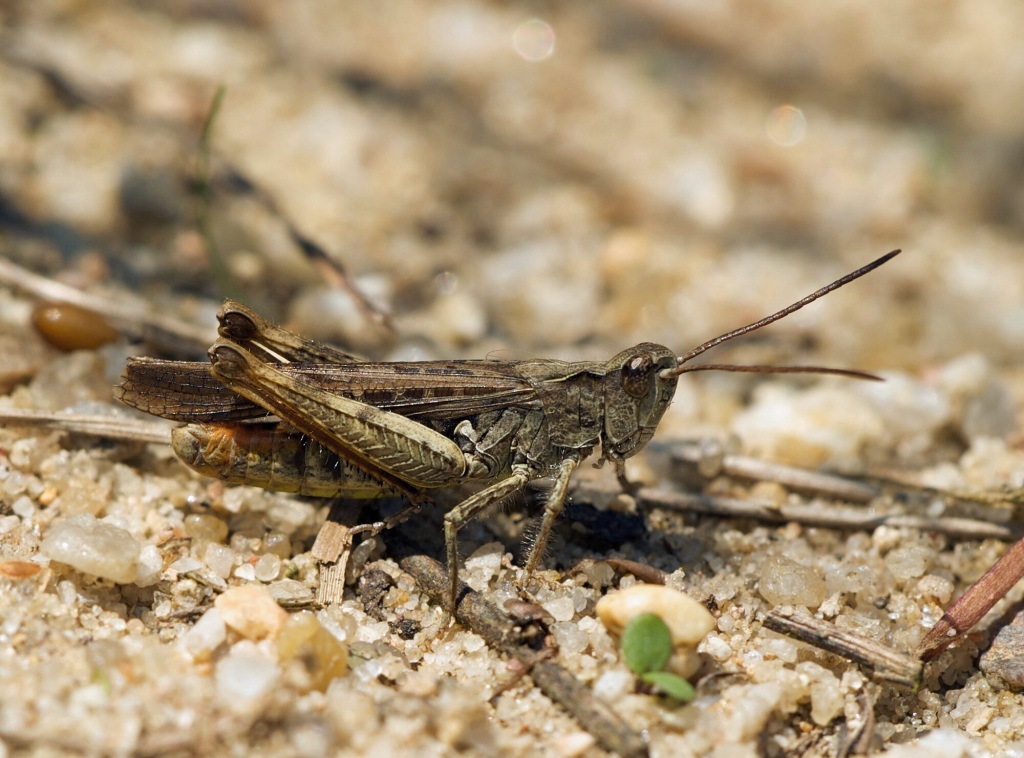
The chirping of grasshoppers is a familiar sound in the British countryside during the summer months and certainly contributing its song to this chorus is the Common Field Grasshopper, Chorthippus brunneus, which is one of our most common and widespread grasshopper species.
Its scientific name is rare in being perfectly descriptive of the creature, (you do wonder how some of them came about!) and comes from the ancient Greek word chor, which means ‘sing’ and also gave rise to the word ‘chorus’, thippus, which means ‘jump’ and brunneus, simply meaning ‘brown’.
Common field grasshoppers belong to an order of insects called the Orthoptera, which derives from the Greek ortho meaning ‘straight’ and ptera meaning ‘wing’, which includes grasshoppers, crickets and locusts. They are fairly large grasshoppers, typically around 2cm long, and while they are usually brown in colour, they also come in a wide array of colours that can include green, brown and purple, but generally with a degree of black, brown or grey markings.

Identification
This variability in colouration and markings means that accurate identification of grasshopper species can require careful examination of the specific shapes and markings of particular body parts. The common field grasshopper can be identified by having a long and angular looking pronotum (the frontmost section of the animal’s thorax) with triangular black markings that don’t quite reach all the way to its back edge.
It also has relatively few ‘stridulatory’ spines on its hind legs (these being the protrusions on the legs that, when rubbed against toughened veins on the forewings, allow the grasshopper to produce its characteristic song).
They are one of the strongest flying grasshoppers we have in this country and are particularly active in warm weather, their preferred habitats being dry and grassy, and they are most common on roadside verges, field margins and waste ground where on sunny days they can often be seen sunbathing on walls, patches of bare soil or on paths.
Their familiar and evocative song consists of a series of chirps, each being around half a second long, males will chirp at each other in turn, a bit like DJs battling, this sonic rivalry is characteristic of the species as is a ‘ticking’ sound they also produce during courtship.

(Andreas Eichler)
Breeding
During the summer the female grasshopper will lay a large clutch of eggs, consisting of up to 15, just below the surface of dry ground or inside anthills, they will stay there over winter before hatching the following May.
Grasshoppers go through a development cycle which is known as ‘incomplete metamorphosis’, in which the larval stages of the insect, known as ‘nymphs’ tend to resemble miniature, wingless versions of the adults. These nymphs will go through a series of moults and eventually they reach their winged, sexually mature, adult form around about June.
Once Common Field Grasshoppers have mated and laid their eggs the adults, which are unable to survive the winter, will die off, this species, however, is better at surviving cold conditions than most other grasshopper species so it’s not unusual for them to survive all the way into December before they finally succumb to the colder weather.

(Aiwok)
On the Grasshopper and Cricket
John Keats (1795-1821)
The poetry of earth is never dead,
when all the birds are faint with the hot sun,
and hide in cooling trees, a voice will run
from hedge to hedge about the new-mown mead,
that is the Grasshopper’s—he takes the lead
in summer luxury,—he has never done
with his delights; for when tired out with fun
he rests at ease beneath some pleasant weed.
The poetry of earth is ceasing never,
on a lone winter evening, when the frost
has wrought a silence, from the stove there shrills
the Cricket’s song, in warmth increasing ever
and seems to one in drowsiness half lost,
the Grasshopper’s among some grassy hills.
A B-H
(June 2024)